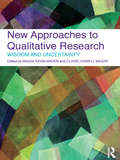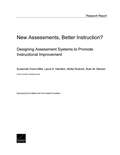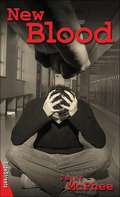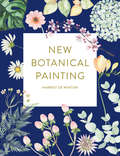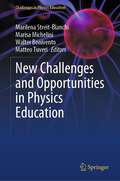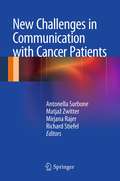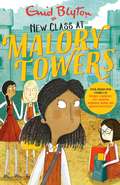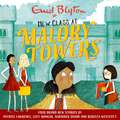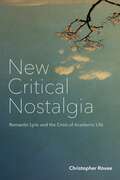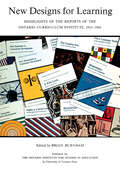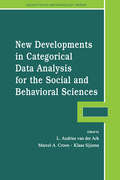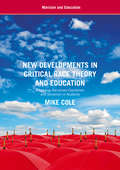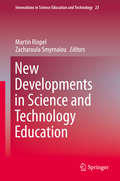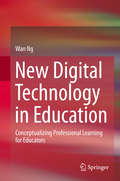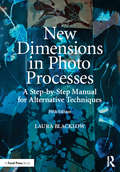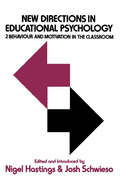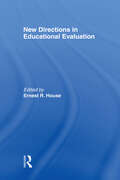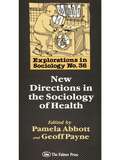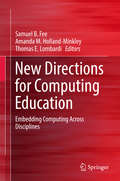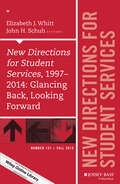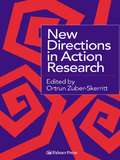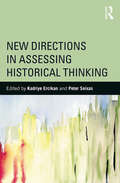- Table View
- List View
New Approaches to Qualitative Research: Wisdom and Uncertainty
by Claire Howell Major Maggi Savin-BadenQualitative research has seen a surge of growth during the past decade. This is in large part because positivist approaches have not yielded the kinds of results that had been anticipated, and more researchers are seeking alternative perspectives to understand phenomena. The number of researchers using qualitative approaches continues to grow, yet there are few up-to-date guides to assist thinking broadly about qualitative research as a field of inquiry. Over the decades the range of approaches has increased, which has led to an even greater lack of certainty about how to think about doing qualitative research. In considering key issues while offering practical guidance on how to work within the face of uncertainty, this book will be a valuable resource to this next generation of researchers. New Approaches to Qualitative Research offers: a clear understanding of the range of issues related to researcher stance, the way that researchers position themselves in relation to their subjects, their participants, and their own belief systems, and the way in which they locate themselves across the qualitative paradigm an overview of some of the most cutting-edge qualitative techniques in use today: from the exploration of visual texts to the concept of inquiry to synthesis methods, this section lays out the state of the art in methodology specific information regarding processes of data analysis, synthesis and interpretation that are employed in these various approaches. In this book, the authors take the stance that qualitative research is a broad approach that encompasses and even encourages difference and uncertainty, and here at last they provide a route-map to this uncertain but fruitful line of inquiry. This vital text is ideal for professional researchers and postgraduates in a range of subject areas.
New Assessments, Better Instruction?: Designing Assessment Systems to Promote Instructional Improvement
by Brian M. Stecher Laura S. Hamilton Susannah Faxon-Mills Mollie RudnickThis report reviews the literature on how assessment affects teaching practice and the conditions that moderate that relationship. The authors identify a wide variety of effects that testing might have on teachers' activities in the classroom and a number of conditions that affect the impact that assessment may have on practice.
New Blood (Lorimer SideStreets)
by Peter McpheeAn edgy yet moving account of violence, bullying, recovery, and hope.
New Botanical Painting
by Harriet de WintonAward-winning artist Harriet de Winton shows you how to create contemporary watercolour artworks to treasure and share. Through more than 30 step-by-step projects, discover how to paint individual flowers and foliage, as well as beautiful botanical compositions. Use your new skills to make art for your wall, unique cards, invitations, or simply paint for pleasure.
New Botanical Painting
by Harriet de WintonAward-winning artist Harriet de Winton shows you how to create contemporary watercolour artworks to treasure and share. Through more than 30 step-by-step projects, discover how to paint individual flowers and foliage, as well as beautiful botanical compositions. Use your new skills to make art for your wall, unique cards, invitations, or simply paint for pleasure.
New Cambridge Bible Commentary: Mark
by Darrell BockThis volume provides a comprehensive, accessible introduction to the Gospel of Mark, now widely considered the first recorded treatment of Jesus. Darrell Bock explains how this text, once the least-used gospel, came to be regarded as the starting point for understanding Jesus. Drawing together previous arguments and discussion in a constructive summary, he traces the significance of Mark and addresses key features such as its cultural and historical background, its narrative flow, and the role of Greek in supplying meaning. This commentary highlights the issues Mark's gospel raises and develops Mark's message surrounding Jesus' claims of kingdom authority and salvation, the call to disciples to follow him, and the preparation of those disciples to face suffering in light of their choice. Mark will be a valuable resource for students, teachers, and pastors alike.
New Challenges and Opportunities in Physics Education (Challenges in Physics Education)
by Marisa Michelini Marilena Streit-Bianchi Walter Bonivento Matteo TuveriThis book is invaluable for teachers and students in high school and junior college who struggle to understand the principles of modern physics and incorporate scientific methods in their lessons. It provides interactive and multidisciplinary approaches that will help prepare present and future generations to face the technological and social challenges they will face. Rather than using a unidirectional didactic approach, the authors - scientists, philosophers, communication experts, science historians and science education innovators - divide the book into two parts; the first part, “Communicating Contemporary Physics”, examines how new physics developments affect modern culture, while the second part, “Digital Challenges for Physics Learning”, covers physics education research using ICT, plus the experiences of classroom teachers and a range of ideas and projects to innovate physics and STEM teaching.
New Challenges in Communication with Cancer Patients
by Richard Stiefel Antonella Surbone Matjaž Zwitter Mirjana RajerThe relationship between oncologists and their cancer patients is rapidly evolving. Oncologists and other cancer professionals master new anticancer and supportive treatment options, while working under increasing economic pressure and time constraints, and are often unprepared to deal with all the challenges of their new position in a therapeutic relationship with cancer patients and families. Good communication is as essential as are modern laboratory tests and sophisticated diagnostics to achieve the best clinical results. This book updates the evolution of truth-telling and communication patterns worldwide and offers insights into the recent trends and emerging challenges in communication with cancer patients and families. New Challenges in Communication with Cancer Patients is an invaluable resource to medical professionals, educators and patients in establishing a strong and effective partnership built on trust and mutual understanding.
New Class at Malory Towers: Four brand-new Malory Towers (Malory Towers #13)
by Enid Blyton Narinder Dhami Lucy Mangan Patrice Lawrence Rebecca Westcott SmithIt's time to welcome new girls to Malory Towers, the famous boarding school by the sea, in four brand-new stories by outstanding authors, set in Enid Blyton's much-loved school.YA and Waterstones Book Prize-winner Patrice Lawrence introduces us to proud Marietta with her magnificent head of braided hair. A dormitory argument reveals something unusual about Marietta, and something equally unexpected about Alicia.In Guardian and Stylist columnist Lucy Mangan's story, student librarian Evelyn is wary of her lively, lacrosse-playing classmates. When one of them becomes a regular visitor to the hushed domain of the library, can Evelyn really trust her?Sunita Sharma joins Malory Towers surrounded by a sense of mystery, in Narinder Dhami's fabulous story. But is Sunita really as glamorous as Gwendoline imagines?In Rebecca Westcott's heartwarming story, Darrell and friends fear the worst when spoilt Gwendoline's cousin joins the school. But Maggie is very different from her stuck-up relative . . .
New Class at Malory Towers: Four brand-new Malory Towers (Malory Towers #13)
by Enid Blyton Narinder Dhami Lucy Mangan Patrice Lawrence Rebecca WestcottIt's time to welcome new girls to Malory Towers, the famous boarding school by the sea, in four brand-new stories by outstanding authors, set in Enid Blyton's much-loved school, in its original time period.YA and Waterstones Book Prize-winner Patrice Lawrence introduces us to proud Marietta with her magnificent head of braided hair. A dormitory argument reveals something unusual about Marietta, and something equally unexpected about Alicia.In Guardian and Stylist columnist Lucy Mangan's story, student librarian Evelyn is wary of her lively, lacrosse-playing classmates. When one of them becomes a regular visitor to the hushed domain of the library, can Evelyn really trust her?Sunita Sharma joins Malory Towers surrounded by a sense of mystery, in Narinder Dhami's fabulous story. But is Sunita really as glamorous as Gwendoline imagines?In Rebecca Westcott's heartwarming story, Darrell and friends fear the worst when spoilt Gwendoline's cousin joins the school. But Maggie is very different from her stuck-up relative . . .
New Critical Nostalgia: Romantic Lyric and the Crisis of Academic Life (Lit Z)
by Christopher RoveeNew Critical Nostalgia weighs the future of literary study by reassessing its past. It tracks today's impassioned debates about method back to the discipline’s early professional era, when an unprecedented makeover of American higher education with far-reaching social consequences resulted in what we might call our first crisis of academic life. Rovee probes literary study’s nostalgic attachments to this past, by recasting an essential episode in the historiography of English—the vigorous rejection of romanticism by American New Critics—in the new light of the American university’s tectonic growth. In the process, he demonstrates literary study’s profound investment in romanticism and reveals the romantic lyric’s special affect, nostalgia, as having been part of English’s professional identity all along. New Critical Nostalgia meticulously shows what is lost in reducing mid-century American criticism and the intense, quirky, and unpredictable writings of central figures, such as Cleanth Brooks, Josephine Miles, and W. K. Wimsatt, to a glib monolith of New Critical anti-romanticism. In Rovee’s historically rich account, grounded in analysis of critical texts and enlivened by archival study, readers discover John Crowe Ransom’s and William Wordsworth’s shared existential nostalgia, witness the demolition of the “immature” Percy Shelley in the revolutionary textbook Understanding Poetry, explore the classroom give-and-take prompted by the close reading of John Keats, consider the strange ambivalence toward Lord Byron on the part of formalist critics and romantic scholars alike, and encounter the strikingly contemporary quantitative studies by one of the mid-century’s preeminent poetry scholars, Josephine Miles. These complex and enthralling engagements with the romantic lyric introduce the reader to a dynamic intellectual milieu, in which professionals with varying methodological commitments (from New Critics to computationalists), working in radically different academic locales (from Nashville and New Haven to Baton Rouge and Berkeley), wrangled over what it means to read, with nothing less than the future of the discipline at stake.
New Designs for Learning: Highlights of the Reports of the Ontario Curriculum Institute, 1963-1966
by Brian BurnhamThe last twenty-five years have seen unprecedented growth in the application of science in critical areas of human endeavor. Explosive acceleration in the rate of growth of learning has created unquestioned benefits but it has also served as a catalyst for social, economic, and political changes of a disturbing nature. Too often there has not been time enough to assimilate the new learning or to reach agreement on the use of powerful new technologies.How have educators responded to the need to prepare young people to live with, create, and control change? In Ontario the response was unique and dramatic. Teachers and academics, school trustees, administrators, and inspectors as well as the provincial government and private philanthropy came together to create the Ontario Curriculum Institute, chartered as a non-profit organization in January 1963. Its objectives were to study all phases of the curriculum in the schools and universities of Ontario and to disseminate the results of their research and developmental work. Studies of course content, of learning processes and instructional methodology, of school and classroom organization were launched and new learning resources, experimental programs, and demonstration classrooms were designed and executed. Findings filled seventeen small volumes to September 1966 after which the reports of the study committees were issued by the Ontario Institute for Studies in Education with which the Curriculum Institute had merged.In New Designs for Learning (which can be considered a sequel to Design for Learning, edited by Northrop Frye, University of Toronto Press, 1962) extracts from all seventeen reports, many now out-of-print, have been organized to deal with the most pressing and interesting aspects of educational reform. Selections were also chosen to provide for educator and layman alike the broadest possible grounds for assessment of the Institute's work. Discerning introductions which set the book and its individual chapters clearly in the mainstream of the curriculum reform movement have been provided by the editor.
New Developments in Categorical Data Analysis for the Social and Behavioral Sciences (Quantitative Methodology Series)
by L. Andries van der Ark, Marcel A. Croon and Klaas SijtsmaCategorical data are quantified as either nominal variables--distinguishing different groups, for example, based on socio-economic status, education, and political persuasion--or ordinal variables--distinguishing levels of interest, such as the preferred politician or the preferred type of punishment for committing burglary. This new book is a collection of up-to-date studies on modern categorical data analysis methods, emphasizing their application to relevant and interesting data sets.This volume concentrates on latent class analysis and item response theory. These methods use latent variables to explain the relationships among observed categorical variables. Latent class analysis yields the classification of a group of respondents according to their pattern of scores on the categorical variables. This provides insight into the mechanisms producing the data and allows the estimation of factor structures and regression models conditional on the latent class structure. Item response theory leads to the identification of one or more ordinal or interval scales. In psychological and educational testing these scales are used for individual measurement of abilities and personality traits.The focus of this volume is applied. After a method is explained, the potential of the method for analyzing categorical data is illustrated by means of a real data example to show how it can be used effectively for solving a real data problem. These methods are accessible to researchers not trained explicitly in applied statistics. This volume appeals to researchers and advanced students in the social and behavioral sciences, including social, developmental, organizational, clinical and health psychologists, sociologists, educational and marketing researchers, and political scientists. In addition, it is of interest to those who collect data on categorical variables and are faced with the problem of how to analyze such variables--among themselves or in relation to metric variables.
New Developments in Critical Race Theory and Education: Revisiting Racialized Capitalism and Socialism in Austerity (Marxism and Education)
by Mike ColeThis book considers new developments in Critical Race Theory (CRT) in times of austerity and assesses both the impact of British CRT or ‘BritCrit’, and CRT’s continuing growth in the US. Following transatlantic impact of the first and only book-length response from a Marxist perspective—Critical Race Theory and Education: A Marxist Response—Cole includes a retrospective critique and development of certain arguments in that volume; an evaluation of the influential ‘Race Traitor’ movement, including observations on the (changing) political perspectives of Ignatiev and Garvey; and reflections on racialized neoliberal capitalism in the era of austerity and immiseration. While acknowledging CRT’s strengths, this book stresses the need for (neo-) Marxist analysis to fully understand and challenge racism in the UK and the US and to envision a socialism for the twenty-first century.
New Developments in Science and Technology Education
by Martin Riopel Zacharoula SmyrnaiouThis book explores the beneficial impact of pedagogically updated practices and approaches in the teaching of science concepts as well as elaborates on future challenges and emerging issues that address Science and Technology Education. By pointing out new research directions it informs educational practices and bridges the gap between research and practice providing information, ideas and new perspectives. The book also promotes discussions and networking among scientists and stakeholders such as researchers, professors, students and companies developing educational software and ICT tools. The volume presents papers from the First International Conference on "New Developments in Science and Technology Education" (1st NDSTE) that was structured around four main thematic axes Modern Pedagogies in Science and Technology Education, New Technologies in Science and Technology Education, Teaching and Learning in the light of Inquiry learning Methods and Interest, Attitude and Motivation in Science.
New Digital Technology in Education
by Wan NgThis book addresses the issues confronting educators in the integration of digital technologies into their teaching and their students' learning. Such issues include a skepticism of the added value of technology to educational learning outcomes, the perception of the requirement to keep up with the fast pace of technological innovation, a lack of knowledge of affordable educational digital tools and a lack of understanding of pedagogical strategies to embrace digital technologies in their teaching. This book presents theoretical perspectives of learning and teaching today's digital students with technology and propose a pragmatic and sustainable framework for teachers' professional learning to embed digital technologies into their repertoire of teaching strategies in a systematic, coherent and comfortable manner so that technology integration becomes an almost effortless pedagogy in their day-to-day teaching. The materials in this book are comprised of original and innovative contributions, including empirical data, to existing scholarship in this field. Examples of pedagogical possibilities that are both new and currently practised across a range of teaching contexts are featured.
New Dimensions in Photo Processes: A Step-by-Step Manual for Alternative Techniques (Alternative Process Photography)
by Laura BlacklowNew Dimensions in Photo Processes invites artists in all visual media to discover contemporary approaches to historical techniques. Painters, printmakers, and photographers alike will find value in this practical book, as these processes require little to no knowledge of photography, digital means, or chemistry. Easy to use in a studio or lab, this edition highlights innovative work by internationally respected artists, such as Robert Rauschenberg, Chuck Close, Mike and Doug Starn, and Emmet Gowin. In addition to including new sun-printing techniques, such as salted paper and lumen printing, this book has been updated throughout, from pinhole camera and digital methods of making color separations and contact negatives to making water color pigments photo-sensitive and more. With step-by-step instructions and clear safety precautions, New Dimensions in Photo Processes will teach you how to: Reproduce original photographic art, collages, and drawings on paper, fabric, metal, and other unusual surfaces. Safely mix chemicals and apply antique light-sensitive emulsions by hand. Create imagery in and out of the traditional darkroom and digital studio. Relocate photo imagery and make prints from real objects, photocopies, and pictures from magazines and newspapers, as well as from your digitial files and black and white negatives. Alter black and white photographs, smart phone images, and digital prints.
New Dir. In Education Evaluati
by Ernest R. HouseFirst published in 2004. Routledge is an imprint of Taylor & Francis, an informa company.
New Dir. In Education Psycholo
by Nigel Hastings Josh SchwiesoFirst published in 1987. Routledge is an imprint of Taylor & Francis, an informa company.
New Directions In Educational Evaluation
by Ernest R. HouseFirst published in 1986. Routledge is an imprint of Taylor & Francis, an informa company.
New Directions In The Sociology Of Health (Routledge Library Editions: British Sociological Association Ser. #14)
by Geoff Payne Pamela AbbottThe sociology of medicine has come a long way from its origins in epidemiology and clinical practice. Like all specialist areas of study it has developed its own internal debates, over the years there has been a shift from a sociology in medicine to a sociology of medicine, and from a sociolgy of medicine, towards a sociology of health and illness. It is to the development of this latter perspective that this volume is addressed.
New Directions for Computing Education
by Samuel B. Fee Amanda M. Holland-Minkley Thomas E. LombardiWhy should every student take a computing course? What should be the content of these courses? How should they be taught, and by whom? This book addresses these questions by identifying the broader reaches of computing education, problem-solving and critical thinking as a general approach to learning.The book discusses new approaches to computing education, and considers whether the modern ubiquity of computing requires an educational approach that is inherently interdisciplinary and distinct from the traditional computer science perspective. The alternative approach that the authors advocate derives its mission from an intent to embed itself within an interdisciplinary arts and science context.An interdisciplinary approach to computing is compellingly valuable for students and educational institutions alike. Its goal is to support the educational and intellectual needs of students with interests in the entire range of academic disciplines. It capitalizes on students’ focus on career development and employers’ demand for technical, while also engaging a diverse student body that may not possess a pre-existing interest in computing for computing’s sake. This approach makes directly evident the applicability of computer science topics to real-world interdisciplinary problems beyond computing and recognizes that technical and computational abilities are essential within every discipline. The book offers a valuable resource for computer science and computing education instructors who are presently re-thinking their curricula and pedagogical approaches and are actively trying new methods in the classroom. It will also benefit graduate students considering a future of teaching in the field, as well as administrators (in both higher education and high schools) interested in becoming conversant in the discourse surrounding the future of computing education.
New Directions for Student Services, 1997-2014: New Directions for Student Services, Number 151 (J-B SS Single Issue Student Services)
by John H. Schuh Elizabeth J. WhittStudent affairs has changed greatly in the almost twenty years that the series editors have been managing New Directions for Student Services. This volume provides a look back at this period of time from 1997 through 2014 with topical chapters focused on: trends in student affairs during the past two decades, changes in students and the most effective student affairs responses, progress and recommendations for assessment in student affairs, and challenges with and skills needed for digital technologies, finance and budgets, and staff preparation. The volume concludes with a look into the future of student affairs practice based in part on the lessons learned from looking at the recent past. This is the 151st volume of this Jossey-Bass higher education quarterly series. An indispensable resource for vice presidents of student affairs, deans of students, student counselors, and other student services professionals, New Directions for Student Services offers guidelines and programs for aiding students in their total development: emotional, social, physical, and intellectual.
New Directions in Action Research
by Ortrun Zuber-SkerrittFirst published in 1996. Routledge is an imprint of Taylor & Francis, an informa company.
New Directions in Assessing Historical Thinking
by Kadriye Ercikan Peter SeixasNew technologies have radically transformed our relationship to information in general and to little bits of information in particular. The assessment of history learning, which for a century has valued those little bits as the centerpiece of its practice, now faces not only an unprecedented glut but a disconnect with what is valued in history education. More complex processes—historical thinking, historical consciousness or historical sense making—demand more complex assessments. At the same time, advances in scholarship on assessment open up new possibilities. For this volume, Kadriye Ercikan and Peter Seixas have assembled an international array of experts who have, collectively, moved the fields of history education and assessment forward. Their various approaches negotiate the sometimes-conflicting demands of theoretical sophistication, empirically demonstrated validity and practical efficiency. Key issues include articulating the cognitive goals of history education, the relationship between content and procedural knowledge, the impact of students’ language literacy on history assessments, and methods of validation in both large scale and classroom assessments. New Directions in Assessing Historical Thinking is a critical, research-oriented resource that will advance the conceptualization, design and validation of the next generation of history assessments.
